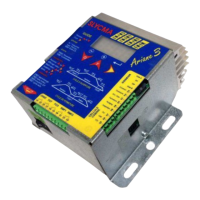Ref : 26702 16 07/01/15
OPERATING VALUES
The speeds correspond to the frequency sent to the motor and
therefore are expressed in Hz.
They correspond to the various door opening and closing phases. They are called
by their abbreviation : FP-O = Opening Cruise Frequency, or FP-F = Closing
Cruise Frequency
The acceleration or deceleration ramps correspond to the time it
takes to go from 0 to 50 Hz, or from 50 to 0 Hz. They are expressed
in seconds.
By reducing the ramp value, the speed is more abruptly changed, and conversely.
They are called by their abbreviation : RD-O = Opening Deceleration Ramp and
RD-F = Closing Deceleration Ramp.
The travels are expressed in encoder point, which corresponds
roughly to millimetres.
The skate travels allow locking or unlocking the locks in slow speed in order to
minimise the noise.
The slow travels allow adjusting the door dockings according to their speed or
their inertia.
The hardnesses are expressed in % of speed drop.
The card records the real cruise speed each time the door is opened or closed and
analyses abnormal deviations. An exceeding of the adjusted percentage in DURF
during closing triggers a re-opening, and in DURO for opening triggers a finger
unjamming movement for glazed doors.
The torques are directly dependent on the voltage sent to the
motor and therefore are expressed in Volts.
A minimum voltage value is defined for a frequency of 2 Hz (U1-..) and a
maximum voltage value for a frequency of 50 Hz (U2-..).
The voltage sent to the motor for the operation is calculated between these two
extreme values according to the frequency.
There are two separate parameter settings :
Moving torques
Opening (U1-O, U2-O), closing (U1-F, U2-F) and skate (U1-S, U2-S).
Braking torque : U-FR
It allows holding heavy doors better when operation at high speeds is
desired.

